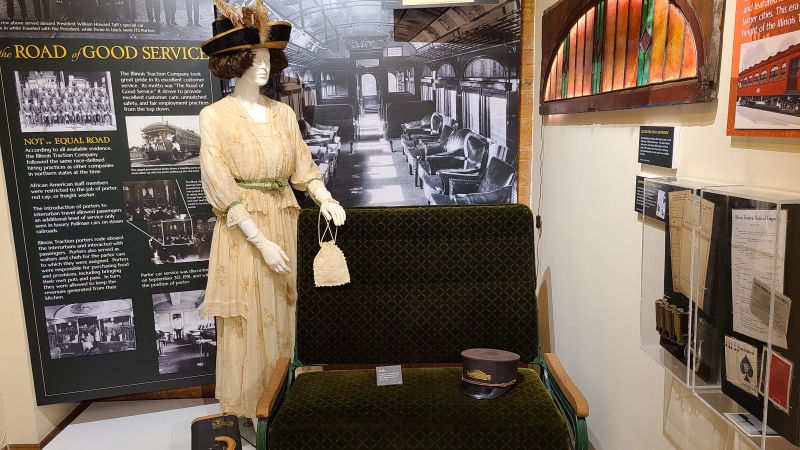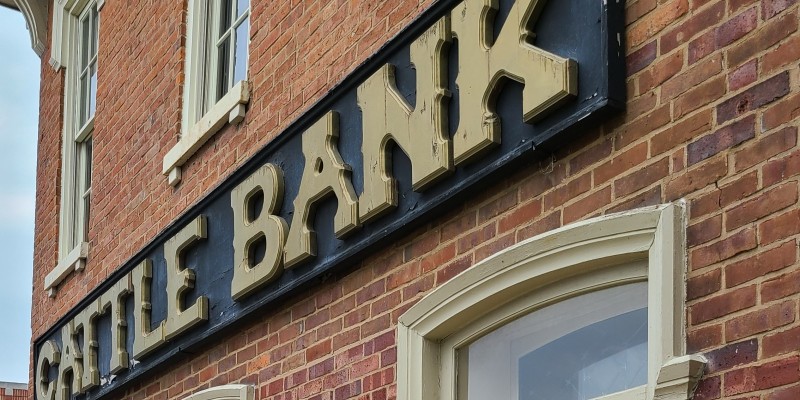The Champaign County History Museum shook things up in 2015 when they decided to move to the Cattle Bank building, which is the oldest documented commercial building in Champaign County. They spent over a year making the transition, focusing on raising money and envisioning a new path. T.J. Blakeman was elected President during that important meeting when everything shifted. Blakeman is also Exhibits Committee Chair. Blakeman, who is the Senior Planner for Economic Development for the City of Champaign by day, spoke with me about running a volunteer-dependent non-profit museum during a pandemic as well as the future of the museum.
“Local History has always been a passion,” said Blakemna. “It goes way back to my childhood. I grew up in the small farm town of Ashland, Illinois. Even at a young age. I still remember as a Cub Scout helping move our public library to a new building. It was this old bank and they used the vault to store all of the pictures of town. I just loved it. During the summer, I would just spend my summers digging through piles of pictures, and I’d walk around and talk to business owners. It was always just my passion as a child. So fast forward, I graduated from U of I with a degree in Urban and Regional Planning. I become a city planner for Champaign, working primarily trying to revitalize downtown. History is a huge piece of that puzzle. Planning blends all of these passions. And then the museum gives me this chance to actually take it to the next level.”

Photo by Jaclyn Jones.
The Museum has four current exhibits and is there is no cost to enter. Three of the exhibits —William McKinley’s Road of Good Service, The Great Harris Mansion Heist, Inspirato da Torre di Civita: The Paintings of Marajen Stevick Chinigo — are downstairs. One exhibit — Zuppke en la Playa: Sketches of a Gridiron Great — is upstairs. Referring to the new direction of the museum since 2015, Blakeman said, “We have to keep proving our worth to the community for them to see us as a real asset that was missing before. We weren’t moving the needle, we weren’t helping the conversation. So hopefully our exhibits are telling stories, our research capacity has grown. And, you know, hopefully people recognize that it’s a hard thing to get people to come into the building. Everybody knows what the Cattle Bank is. We want people to come in and see. Everybody who comes in says, ‘Wow, I didn’t know. I thought this was gonna be some little thing.’ They all walk away really impressed. That makes me really happy. But now I just want more people to come in and see it.”
Part of proving their worth involves a wealth of online resources including blog posts about local history and online archives. They also send out a monthly newsletter that includes an interesting story. The August newsletter included a story about the Soviet Union gymnastics team coming to Champaign in 1961 during the height of the Cold War. “Most people don’t even realize. A Soviet-US cultural exchange program happened right here. We have the program; we’ve got press passes. We’ve got pictures,” Blakeman said.
Running a museum during a pandemic
As for running a non-profit during a pandemic, the Museum was able to keep their one part-time staff person on board and saw their membership keep steady and some people even increased their membership levels. They did miss out on their suggested donation box which is downstairs at the entrance and were not able to hold their key annual event — History on the Town — in which they choose a historic location in Champaign County and invite members to explore behind the scenes. Their annual meeting moved to online and their speaker events series as well as a trivia night was canceled. Those were all opportunities to bring people together and, in some cases, bring people into the building to be impressed by all that the museum offers.
Instead, the pandemic allowed them to focus on other things, like sorting through and cataloguing the materials they did have, especially The News-Gazette collection. Blakeman said, “We’ve come out of it fine. We had the ability to accept The News-Gazette collection, which was a huge donation, but also take what wasn’t relevant to Champaign County and be able to sell it in a public auction and raise money for the museum. It gave us a huge financial cushion which we never had before. We put that money in reserve, so that nothing like 2015 happens again. Our key has to be to protect the museum and the institution, but also the collection. This collection has been growing for almost 50 years. And it’s our job. We are stewards of that collection. We have to keep it going for the next generation.”
Donating artifacts and telling the story
People frequently walk into the museum to donate artifacts. During my visit, a person walked in soon after me with a donation of a Meadow Gold box containing glass jugs. However, the artifacts are secondary to the story told. Says Blakeman “We’re not somewhere where you can just dump an old historic item that your grandmother had. What is significant? Tell us her story. Why is this one object important to either her story or the story of our county? Like that Meadow Gold box you just saw downstairs, I haven’t heard what the story is, but I know instantly that Meadow Gold was a local milk company and he had some really unique bottles. The box tells the story of how we used to have to have milk delivered every day and then it had to stay cool on your porch.”
In addition to donating artifacts, many people donate their time to the museum. There was a married couple going through artifacts on the day I visited. The couple had been looking for a volunteer opportunity they could do together and now they come in once a week. The museum has a backlog because new artifacts are arriving all the time and they have a large collection. “Our off-site storage where we keep our actual collection is 2500 square feet wall to wall rolling shelves, boxed up to the ceiling. And all of those items need to be reassessed, rehoused, photographed, the records need to be double-checked in our online system. And so there’s always work,” Blakeman said.
Yet the stories told are not just the ones that happened long ago. The pandemic is a great example of a monumental event that people in the future will want to learn from. Cary Frye took photos during the pandemic and that collection is accessible through the museum’s website. They are also collecting other artifacts that tell the story of this time.
This does not have to be some object that is 50 years old. Our job as a museum is to collect things that tell our story. And our story happens every day. We’re trying to do that. During the Women’s March, we have a hat from Westside Park, we have pickets, signs from there. We took pictures specifically when the protests last summer stopped right here at the police station, our building was in the background, kind of front row to that history being made. So we want the pictures. Everybody just thinks historical objects, that’s something that grandma and grandpa had. But we have to do a better job of collecting today. Because someday someone’s going to need to understand what the heck happened. Our history has to be captured every day.
What’s next
Blakeman wants to bring back in-person events. “History is best understood sharing, talking face-to-face, meeting other people, the interactions, you have, hearing stories from other people. It’s critical.” While they have members across the country who they want to reach and keep engaged through online programming, in-person events are also in the plans.
The museum’s gift shop is shifting into a place that offers unique local items — either locally made or items specific to Champaign County. In the past, they mostly sold books and the approach was that people who came in might want to buy something. But they are changing that approach and instead hoping to create a gift shop that is an attraction all its own. “And we keep our eye on the future. So then the question becomes, what’s next? What does this community need? What could it support? We want to think about that, because we think we can play a more important role.”
I want people to come in. I feel like every time somebody walks in, they realize it’s not just this little thing. It’s a real thing. It’s a real history museum, telling real stories, and doing our very best to be as professional about it as possible. We like being here in Midtown. And it’s right here steps from campus and steps from downtown. You can see the whole thing in less than an hour by far. Just stop in.
Champaign County History Museum
102 E. University Avenue
Champaign
W + F 1 to 5 p.m.
Th 1 to 7 p.m.
Sa 10 a.m. to 5 p.m.
Editor’s Note: Blakeman’s quotes have been slightly edited for clarity.








